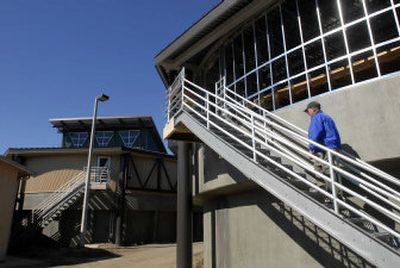Sewage plant to go incognito

Stinky and ugly are out. The Coeur d’Alene sewage treatment plant is getting a makeover so eventually the most sensitive nose and keenest eye likely won’t know raw sewage converges with the ritziest waterfront real estate in the city.
“We don’t need to look like a turd mill,” Wastewater Superintendent Sid Fredrickson said last week while showing off the treatment plant’s newest structures, which look like college buildings with V-shaped windows, artsy roof lines and metal siding in warm green and tan.
Coeur d’Alene wants the plant, which treats an average of 3.5 million gallons of sewage each day, to blend in with its neighbors along the Spokane River.
The city’s waterfront is transforming and the vision is of an educational corridor – a regional hub where students can earn different levels of degrees and access resources from North Idaho College, the University of Idaho, Idaho State University and Lewis-Clark State College.
All this will happen around the wastewater plant, which was built in 1939 on the shoreline because it was the lowest elevation in the city. Until recently, Coeur d’Alene had a working waterfront dotted with lumber mills. Nobody gave thought to the hodgepodge of sewer plant buildings taking up a few acres.
Within 2.5 years the neighboring DeArmond Mill is expected to close, opening the way for the educational corridor project. The sewer plant no longer fits in, but moving it isn’t an option.
Masking sewer facilities has become a national trend. Clark County, which includes Vancouver, Wash., has disguised its wastewater treatment plant and turned the grounds into a public trail system. In Edmonds, Wash., the downtown plant is so pretty there has been at least one wedding on the roof of the clarifier tank – where solids are removed from the wastewater.
“I think it’s been awhile,” said Edmonds Public Works Director Noel Miller about the wedding. He said most people prefer to have such celebrations on the roof of the town library, which offers sweeping views of the Olympic Mountains and Puget Sound. Yet he is proud that the facility blends so well that even tenants from the high-dollar condos looking down on the plant don’t complain.
“It looks like some concrete sports courts are there,” Miller said. “We’ve got landscaping all around the perimeter. From street level it just looks like some concrete building. It’s very innocuous.”
The plant was designed in 1990 by Donn Hogan of HDR Engineering in Bellevue, Wash., the same architect Coeur d’Alene is using.
Hogan said many communities are considering design standards when it comes to public works projects.
“It doesn’t really cost much more to do nice work, than something without any aesthetic merit,” Hogan said. “It’s what you don’t see that is the expensive part. You can wrap it in anything.”
It cost Coeur d’Alene about $1 million extra to make the new $16 million expansion more eye-pleasing. That includes odor control and roofs on the plants to keep birds from eating raw sewage and potentially spreading disease, Fredrickson said.
Eventually the city will retrofit the existing buildings and tanks, giving them matching paint jobs and some architectural work as camouflage. But Councilwoman Dixie Reid sees it as a 20-year project.
For now, the two new buildings near the mill will act as a buffer. Measuring nearly three stories high and with a sloped roof, they will hide the chaotic mixture of old buildings in the middle of the site. The sides are covered in colored concrete and incorporate glass blocks for texture.
Hogan said the goal is to blend with the natural environment.
The city will landscape the shoreline, where a new bike path is expected, in another attempt to hide the plant from the water and the traffic on U.S. Highway 95 crossing the river.
Coeur d’Alene has already built a large, landscaped berm on the north boundary that abuts Harbor Center, where the University of Idaho has classrooms.
“It’s impossible to see right now,” said Jack Dawson, dean of University of Idaho Coeur d’Alene.
Yet visual aesthetics isn’t the most important change.
“The biggest thing they’ve done is odor abatement,” he said. “We have more odor from the mill.”
The stench is pumped from the offending buildings and goes through a treatment process. In the final stage it’s pumped into a layer of compost and wood, which acts as a filter.
You can stand over the area that looks like a bed of landscaping bark and smell nothing except the crisp fall air.
Besides aesthetics and odor control, this latest expansion will increase the plant’s capacity by 6 million gallons per day. By next month, the city will be able to treat 19.5 million gallons of sewage each day. Coeur d’Alene needs the extra capacity to handle new residents and emergencies such as heavy rainstorms that can flood the system, Fredrickson said.
“We want to be the best neighbor we can,” Reid said.